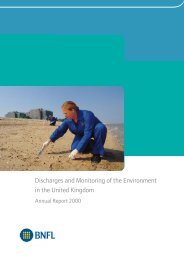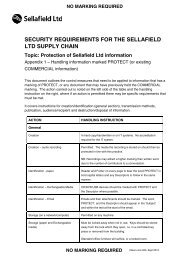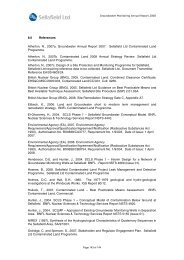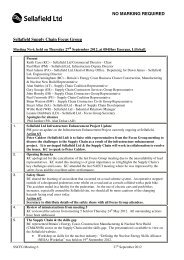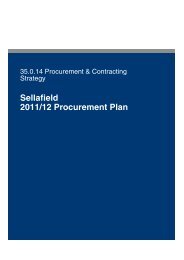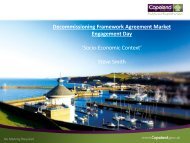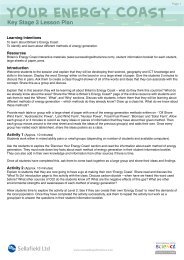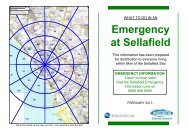Annual Report for 2010/11 and Forward Programme - Sellafield Ltd
Annual Report for 2010/11 and Forward Programme - Sellafield Ltd
Annual Report for 2010/11 and Forward Programme - Sellafield Ltd
Create successful ePaper yourself
Turn your PDF publications into a flip-book with our unique Google optimized e-Paper software.
SSEM/20<strong>11</strong>/4730 June 20<strong>11</strong>Recommendations7 St<strong>and</strong>ard statistical analyses (such as generallinear models, confidence intervals <strong>and</strong>hypothesis tests) be used to explore the beachfinds <strong>and</strong> where appropriate to draw inferencesconcerning the population distributions, factorswhich account <strong>for</strong> the variability in the finds <strong>and</strong>to summarise changes.8 For temporal comparability over monitoringcampaigns, time series of finds should beadjusted <strong>for</strong> monitoring ef<strong>for</strong>t <strong>and</strong> equipmentchanges (see also recommendation 3 <strong>and</strong> 5).9 To assess which beaches should have a highpriority from habit in<strong>for</strong>mation. Monitoring ofthese beaches should have a substantiallygreater footprint (>50 %) consistently to providea better sample of the particle population onthese beaches at a frequency, which iscommensurate with the change in sedimentprofile height between monitoring events. Thischange in sediment height should becomparable to the detection capability <strong>for</strong> theparticle activities of concern (e.g. 100 kBq <strong>for</strong>137 Cs). Beaches with markedly lower particledensities <strong>and</strong> habit characteristics may bemonitored less frequently although morecomprehensively to provide a better estimate ofthe detectable particle population (see alsorecommendation 10).10 The particle density will be greatly influenced bythe depth over which number of particles isestimated. The target detection depth <strong>and</strong>monitoring frequency should be designed toreflect the amount of s<strong>and</strong> <strong>and</strong> there<strong>for</strong>e depthof s<strong>and</strong> being exchanged with the offshoreenvironment (see also recommendation 9).<strong>11</strong> Data layers exist <strong>for</strong> within window, backgroundcounts, detector height <strong>and</strong> beach height data.This provides the possibility of modeling <strong>and</strong>mapping detection capability (probability ofdetection <strong>and</strong> detection limit) <strong>for</strong> each locationon the beach, in a similar way as undertaken atDounreay (Tyler ., <strong>2010</strong>). Such data shouldbe used to provide more particle specific insightinto the likely abundance of particles with depth(see also recommendations 3, 5 & 8).SL initial responseSome of these techniques have already beenemployed <strong>and</strong> will be exp<strong>and</strong>ed, as advised.See response to recommendation 3 <strong>and</strong> 5.Historically, the beach monitoring programmehas focused on high occupancy areas basedon the EA's habit reports. This has beencombined with monitoring of high find rateareas to give a balanced approach. It isjudged that the > 50% footprint has beenachieved <strong>for</strong> beta-rich finds containing 137 Csor 60 Co-rich finds as the 1E+05 Bq limit ofdetection <strong>for</strong> these radionuclides is 30 cm ormore. However, <strong>for</strong> 241 Am the 1E+05 Bq limitof detection is 5 cm making it impracticable toachieve a 50% footprint in the current beachareas over a period of a single tide. Thedefinition of footprint there<strong>for</strong>e needs to bedefined explicitly <strong>for</strong> <strong>Sellafield</strong> finds,recognising that it may be different from thatused at Dounreay. A request will be made tothe Environment Agency <strong>for</strong> the next HabitSurvey to provide more detailed habit datawith respect to the beach occupancy <strong>and</strong> use.The depth of s<strong>and</strong> on beaches between StBees <strong>and</strong> Drigg point is not explicitly known.Practical observations of the appearance <strong>and</strong>disappearance of rocks on the <strong>Sellafield</strong>beach would suggest that an explicit s<strong>and</strong>depth measurement over the 630 hectares ofbeach that can be monitored (or 1400hectares of total beach area) could not berealistically achieved. Consideration will begiven to a practical solution to this problem,such as, an assessment of beach depthbased on the additional data gathered duringthe more frequent visits to the main beachareas.To be considered <strong>for</strong> inclusion into statisticswork programme.© Nuclear Decommissioning Authority 20<strong>11</strong>. 61



